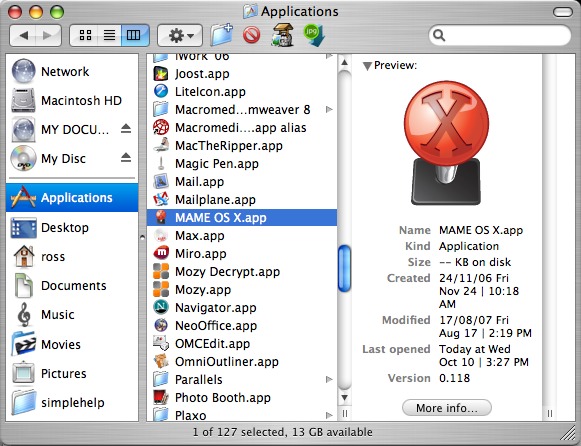

- #Arcade emulator mac os x how to#
- #Arcade emulator mac os x install#
To install MAME4droid (0.139u1) 2021 For MAC, you will need to install an Android Emulator like Bluestacks or Nox App Player first.
#Arcade emulator mac os x how to#
Cross-core UI: if you run other cores, e.g.Update: How To Install MAME4droid (0.139u1) on MAC OSX. Latency options: are quite interesting for the very competitive gamer. Shader options: you can configure a lot of shader options if you are really into it. Joypad support: great to fine tune - you will spend a lot of time here!. Abundance of configuration options: again, many hat this, but these various config options show how much innovation happens in Retroarch and they are worth testing. Retroarch GUI (RGUI): if you get used to this joypad-centric kind of configuration, it is very useful during a running game, you switch to RGUI, change config and see results (this is a very disputed topic, and Retroarch opponents will call RGUI as the main problem, but for me, after quite some time, it is a very good way to test stuff). Valid reasons for trying out MAME in Retroarch: For a stable MAME experience, I still recommend official MAME as the main focus of this Blog. 2 years during that time it made tremendous improvements and added a lot of interesting coresĭisclaimer first: Retroarch (at least on Macs and iOS devices) is very fluid and sometimes experimental. Work-In-Progress: collection of my experience in using Retroarch on Macs and on my iPad for quite some time, i.e. So your highscores are just saved by savestates, and that's just fine. Because OpenEmu, by its default options, just autosaves your last state and resume there at restart. Autostate out of the box: MAME currently does not save hiscore files in OpenEmu, and there is nothing to worry about that. outstanding configuration of joypads, with a lot of them being recognized automatically. neogeo.zip), OpenEmu tells you this also importing of bios files is drag'n'drop (more important for the other emulators) import roms by drag'n'drop and enjoy immediate scans for artwork import also provides a smart mechanism for resolving conflicts with other emulators if you launch a game with missing roms (e.g. And of course outstanding usability, which you will not find in any other MAME emulator:. And you find CRT-GEOM or even CRT-Royale-Kurozumi amongst them! Shader options are also very convenient. It is by far the most convenient way of applying shaders for MAME games. Shaders built in, can be changed in the game on the fly. A more objective testing than playing games you know does not seem to be available. While there is nothing documented about this, so far all games work flawlessly. OpenEmu claims to have developed a Metal backend for better performance in MacOS. Up to date - current MAME Core is 0.217 (note: the MAME Core only comes with the "Experimental" version of OpenEmu!). So you must be in the MAME working directory! Warning: starting mame64 with double-click does not work in the right way -> so start via Terminal as explained here. Open Terminal and switch to your MAME working directory (easiest way: type 'cd' and then drag the mame directory from the Finder into the Terminal -> press Return in the Terminal window) As long as you do not forget about the ini directory when moving to a new MAME version, this is probably easiest to handle, and the /Library/Application Support directory stays clean of MAME config files. ini files created in the first step into the ini subdirectory. This means of course that you have to move the three. 
ini files in the MAME sub-directory called ini, thus I reduce this line as follows: inipath ini ini files in a certain order, you may be lost in chaos. ini files at multiple places rather easily. ini" Recommendation: In my own experience, this is rather unfortunate, because you may end up with multiple. I nipath "$HOME/Library/Application Support/mame $HOME/.mame. By default, mame.ini contains the following multiple ini paths:.Ui.ini - your configuration file for the MEWUI interface

Plugin.ini - your configuration file for activating and deactivating MAME Plugins Mame.ini - your overall configuration file for MAME mame64 -cc generates the three default config files in your mame directory: Now in the Terminal and in the right directory, the command.Start Terminal and cd into your directory of MAME (recommendation: name your main directory mame, see above).This should save you from a lot of headache by multiple. ini files in the Terminal and manually configure ini pathsĪfter a lot of testing, my recommendation is to create your first. This definitely helps you further on to stay consistent and carry on your work from version to version. Recommendation: I currently keep my running MAME version in the folder 'mame' and keep only older versions in a version-related directory.







 0 kommentar(er)
0 kommentar(er)
